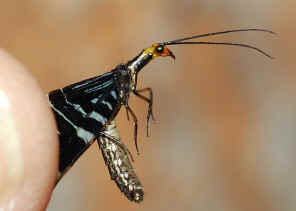|
| |
- We found only one species in this family.
Lacewings in this family are medium in size. Their wings are often
colour-patterned.
Pied Lacewing - Porismus strigatus
- This page contains pictures and information about Australian Osmylid
Lacewings that we found in the Brisbane area, Queensland, Australia.
-

- Body length 35mm
-
- The Lacewings have the steel blue coloured wings with white patterns. The
abdomen is brown covered by its wings. Their head is orange in colour, with
black eyes and black antenna
in filiform. All legs are black to dark brown.
-



-
- From the reference this Lacewing species is not uncommon but we
only saw them once. It was late May, early winter in Eight Mile Plains. We
saw about ten of them resting about 2 to 3 meter from ground on two gum tree
trunks. Some of them were resting facing each others. We watched for a few
minutes and they were not doing anything. Only flied away when we were
almost touching them.
-



-
- We
came back to the two gum trees the next week, and found that they were still
there. Still facing each other in pair, doing nothing.
-
 
 -
- Their larvae are long and slender, with elongated spear-like jaws, hunt
under bark. Their eggs are not stalked.
-
 
 -
- We kept found them on the same tree trunk about the same time un the
following year.
-
- The Osmylid
Lacewings Porismus strigatus is in subfamily Porisminae. This
subfamily have only one species.
- Reference:
- 1. Insects
of Australia, CSIRO, Division of Entomology, Melbourne University
Press, 2nd Edition 1991, pp 535.
- 2. Insects of Australia and New Zealand - R. J. Tillyard, Angus &
Robertson, Ltd, Sydney, 1926, p319.
- 3. Pied Lacewing ( Porismus strigatus) - John Moss, Butterfly and Other Invertebrates Club,
Newsletter Issue 38, Sep 2005, page 5.
- 4. Revision of the Osmylid Subfamilies Porisminae and Eidoporisminae
(Insecta: Neuroptera) - TR New 1983, Australian Journal of Zoology 31(5) 763 - 770
[ Up ] [ Lacewings, Antlions and Owl Flies Biology ] [ Osmylidae ] [ Mantispidae ] [ Hemerobiidae ] [ Chrysopidae ] [ Nymphidae ] [ Myrmeleontinae ] [ Stilbopteryginae ] [ Ascalaphidae ]
| |
|













